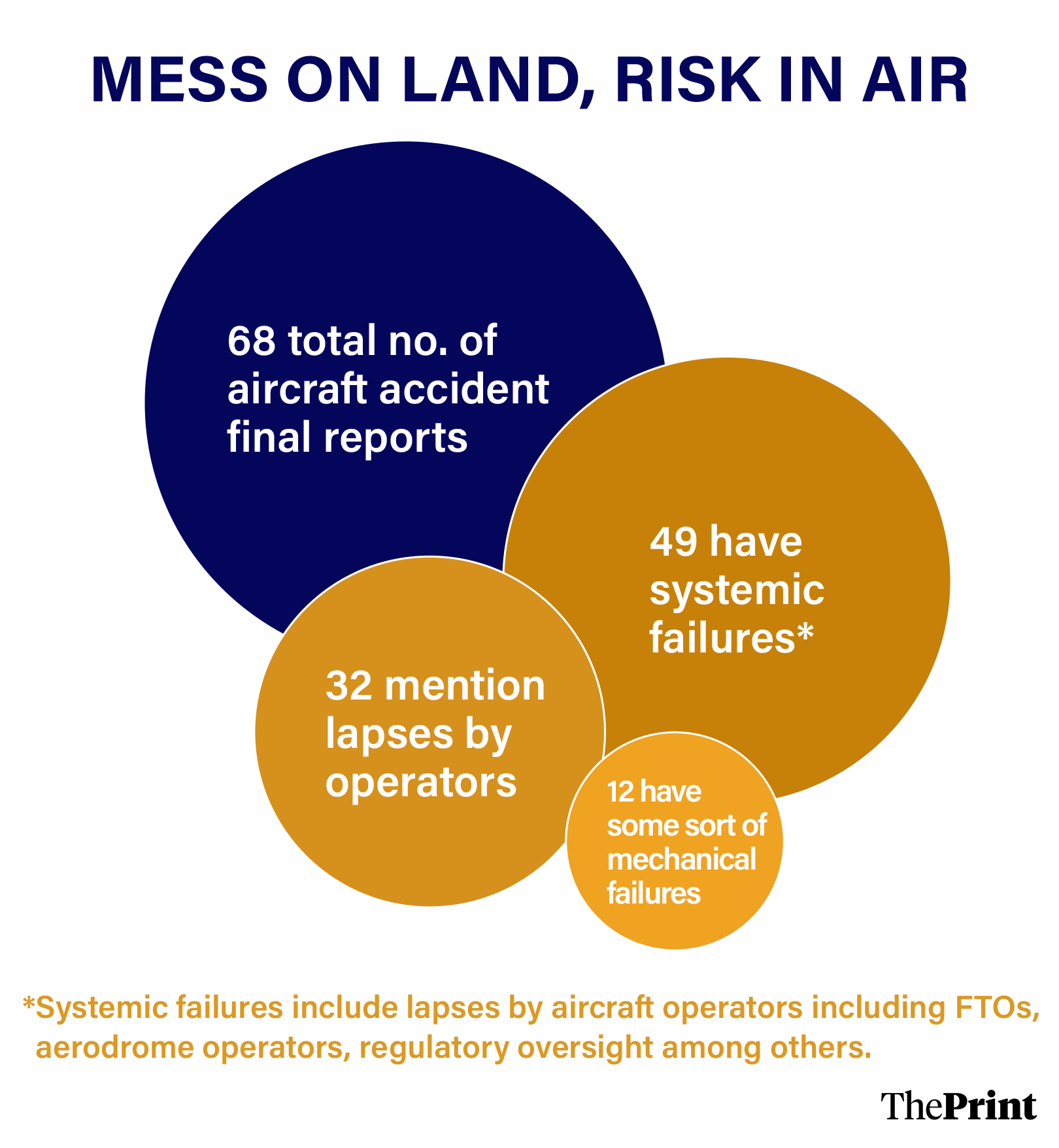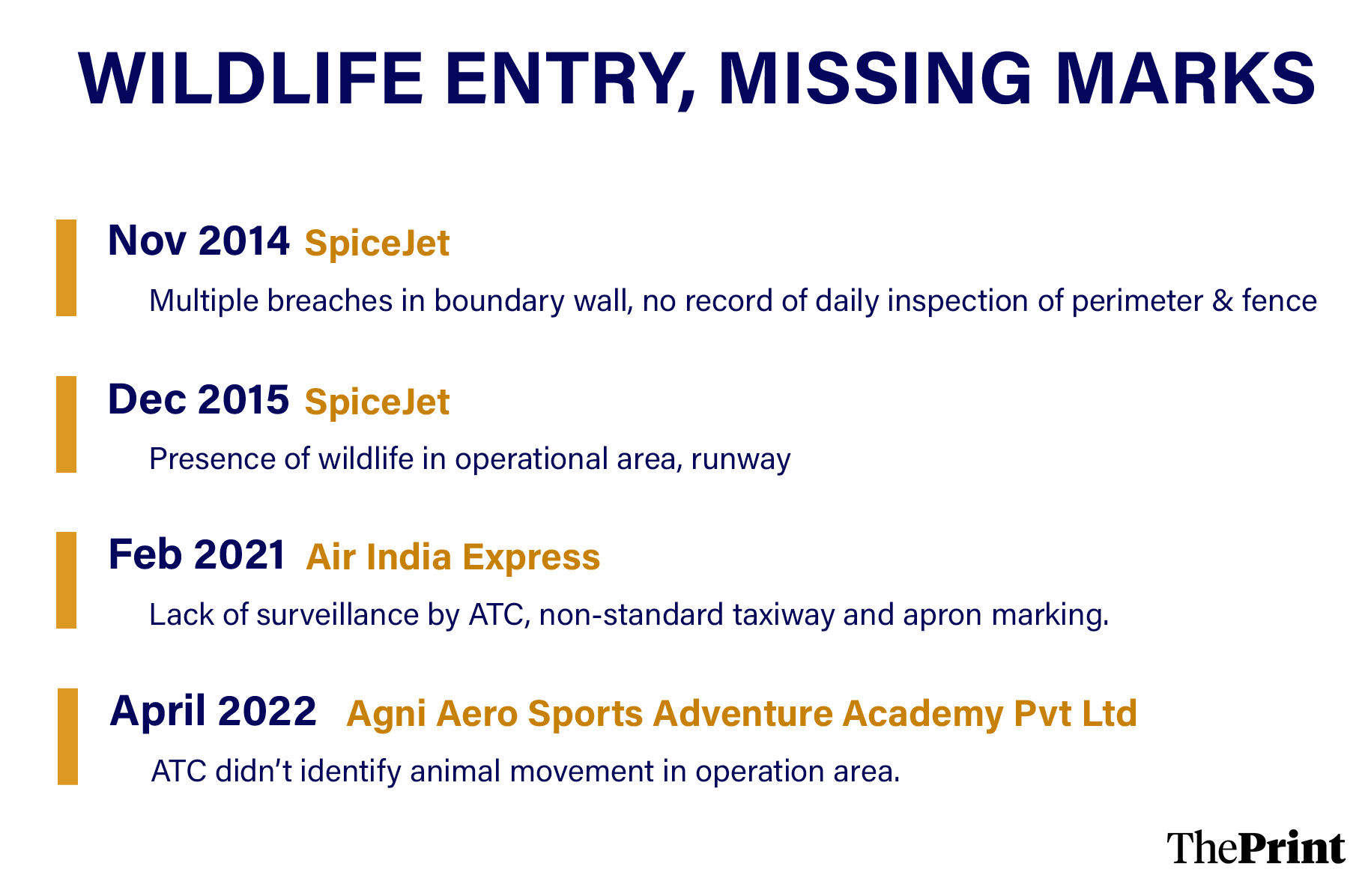This is the concluding part of ThePrint’s three-part series. Read Part 1 here and Part 2 here.
New Delhi: Unsecured runways, faded or confusing markings, neglected wildlife hazards, overgrown vegetation—these are some of the findings of the Aircraft Accident Investigation Bureau (AAIB) in its final probe reports, highlighting a pattern of lapses in responsibility across all levels of airport management as well as regulatory oversight.
The Air India crash in Ahmedabad has put the spotlight on the country’s aviation sector. While the airline has been facing scrutiny after the 12 June crash that killed at least 275 people, the AAIB also drew criticism after it put out its preliminary report.
The concluding part of ThePrint’s three-part analysis of AAIB’s 68 final investigation reports on aircraft accidents put out since 2012 dwells on systemic failures that have largely escaped the headlines.

While Part 2 focused on how the AAIB has cited pilot action in 67 percent of its final reports, Part 1 showed how various operators have faced flak from the Bureau for their recurring pattern of negligence and protocol violations.
Eyes on the watchdog
One prominent subject in the AAIB reports is the conflict between the AAIB and the Directorate General of Civil Aviation (DGCA). Take for example the 2020 Air India Express crash: Officials of the Directorate of Air Safety (DAS), a specialised division within the DGCA, “did not agree to come and meet the investigation team” during their probe in the Kozhikode accident.
The meeting was called to clarify and discuss ambiguities related to information the DGCA provided about the Flight Operations Quality Assurance monitoring, a system that collects and analyses flight data for safety oversight.
The DGCA skipping the meet was a violation of the Aircraft (Investigation of Accidents and Incidents) Rules, 2017, the AAIB said. Moreover, it mentioned that the aviation watchdog’s Civil Aviation Requirements (CAR) on monitoring of Digital Flight Data Recorder (DFDR) data for accident or incident prevention “contains ambiguities in values of exceedance parameters”.
“These ambiguities were not addressed in spite of clear recommendations by the previous Court of Inquiry (COI) for the Mangalore crash 2010,” the AAIB noted.
The COI probing the Air India Express Flight 812 crash, which claimed the lives of 158 people, recommended that CAR needs to be amended to remove any ambiguity regarding the exceedance limits (i.e., safety thresholds).
However, the AAIB report notes that even though the CAR was revised in 2017, the amendments “didn’t address or remove any ambiguity regarding the exceedance limits”.
The final report that came out in 2021 noted that the DGCA wasn’t carrying out surveillance of flights operating to critical airfields and red-eye flights.
As the primary investigating agency for aircraft accidents and incidents, the AAIB functions separately from the DGCA, which functions as a watchdog to oversee compliance with rules and regulations.
In another instance, the AAIB found that, “proper CAR compliance was not carried out by the regulator (the DGCA) before approval of the operator’s Operations Manual”.
This was mentioned in its final report of an accident involving an aircraft operated by the Directorate of Aviation (DoA), Madhya Pradesh in 2021. Moreover, the agency noted that the accountable manager at DoA was approved despite having no aviation background.
Captain Amit Singh of Safety Matters Foundation called for an “overhaul” to ensure safety in the skies.
“In Indian aviation, who audits the auditor? The need of the hour is a total overhaul, something drastic as the safety culture is beyond deterioration. Everybody is working for themselves; nobody is really bothered about safety. Past recommendations have also been buried,” Singh told ThePrint.
Both the AAIB and the DGCA, Singh alleged, work for appeasement of the Ministry of Civil Aviation. “Former airline guys working with them is also a conflict of interest. The appointments take place from the ministry. So how is the AAIB going to conduct probes independently? They are functioning in a bureaucratic manner.”
“There is a lack of independent human resources in the aviation bodies, with no clear safeguard against any conflict of interest. Half of the DGCA’s posts are lying vacant,” Singh added.
In July, Civil Aviation Minister Ram Mohan Naidu informed the Rajya Sabha that 190 out of 410 DGCA vacancies would be filled this year.
Also Read: Air India crash: Data from recovered AI-171 Black Box downloaded, analysis underway
Broken walls & guard
In December 2015, a SpiceJet flight carrying 49 passengers hit wild boars while landing at Jabalpur. The AAIB identified the presence of wildlife in the operational area as well the runway as a contributing factor to the accident in its final report.
It found 20 breaches in the airfield’s perimeter wall as well as several openings at the bottom of the walls. “They were adequate for the wildlife animals to enter the aerodrome premises at any time of the day,” the report noted.
The Jabalpur airfield and Air Traffic Control (ATC) are controlled by the Airports Authority of India (AAI).

Something similar happened in 2014 when a SpiceJet aircraft with 151 passengers hit a buffalo on the runway at Surat airport. Here too, the AAIB found multiple breaches in the boundary wall. Its report also noted that while the AAI rules stipulate daily inspection of perimeter and fence, no record was maintained.
Another such case was reported at Karnataka’s Jakkur aerodrome where the aircraft was substantially damaged in 2022. The AAIB report mentioned “area near the broken perimeter wall not fully secured”, as a contributory factor among others. “Animal movement in the operational area was not identified by ATC,” it added.
Moreover, the report noted that there was excessive bird activity on the runway and no measures were taken to restrict it.
“A portion (approximately 144 m) of periphery wall on the North Eastern side of the airfield, left of runway 26, is open. This open area is manned by a security guard, but no measure has been taken to secure it by means of barbed wires or fencing. Therefore, hazardous situations in the operational area due to a stray animal cannot be ruled out,” the AAIB stated.
This aerodrome is owned by the Government Flying Training School (GFTS), Karnataka and ATC services are provided by the school.
Missing markings & CCTV footage
In its report on the 2021 accident of an Air India Express plane, the AAIB noted that the aerodrome operator at Vijayawada airport took no action in spite of repetitive observation by the regulator (DGCA) on aerodrome markings. Vijayawada airport is operated and managed by the AAI.
The taxiway and apron markings weren’t as per standards. In a few places, the erased taxiway markings were in white, which didn’t match the tarmac and were still visible. “It might create doubt in the mind of the crew,” the AAIB report said.
The apron markings were faded and confusing. “Alphabets and Digits are not as per standard sizes. Markings which are not in use were either not erased properly or were blurred. It has been noted in the past that ambiguity or confusion for the markings were raised by the pilots to ATC,” the AAIB stated.
The report also noted that the ATC lacked surveillance in the apron area and that the aeronautical charts by the AAI were found to have not been updated.
In June 2023, a Cessna 172S Skyhawk SP exited the runway and hit a paver machine at Bhiwani aerodrome—owned by the Haryana government—while carrying out a training flight. The aerodrome is leased to FSTC Flying School Private Limited for flight training in accordance with the DGCA-approved flying training organisation (FTO) permit.
The final report notes that the CCTV cameras overlooking the runway were reported to be non-functional. However, this was not communicated to the DGCA as mandated by the DGCA Flying Training Circular 1 of 2022.
Covering aspects like application process, instructor qualifications, and syllabus for training courses, the above-mentioned circular outlines the process for organisations to get authorisation to provide remote pilot training.
(Edited by Tony Rai)
Also Read: Recurring aircraft defects to faded runway lines, DGCA check reveals safety lapses at key airports






